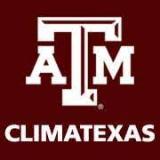Exceptional drought continues to expand in Texas, Oklahoma, New Mexico, and Kansas.
Drought is likely to worsen in the coming weeks and months.
Key Points
- Exceptional drought (D4) has developed over parts of Texas, Oklahoma, and southwest Kansas.
- Severe (D2) and extreme (D3) drought have developed across central Texas and Oklahoma, raising concerns for agricultural impacts going into the growing season.
- Above-normal fire risk is in place for drought-stricken regions of the Southern Plains.
- Despite spotty above-average precipitation in far south Texas and northwest Kansas, drought is likely to persist through June.
The U.S. Drought Monitor is updated each Thursday to show the location and intensity of drought across the country. Drought categories show experts’ assessments of conditions related to dryness and drought including observations of how much water is available in streams, lakes, and soils compared to usual for the same time of year.
This map shows drought conditions across the Southern Plains Drought Early Warning System as of March 15, 2022.
U.S. Drought Monitor Categories
The U.S. Drought Monitor is updated each Thursday to show the location and intensity of drought across the country. Drought categories show experts’ assessments of conditions related to dryness and drought including observations of how much water is available in streams, lakes, and soils compared to usual for the same time of year.
This map shows drought conditions across the Southern Plains Drought Early Warning System as of March 15, 2022.
Current Drought Conditions and Outlook
U.S. Drought Monitor Conditions
- 90% of the region is in drought (D1 or worse).
- 42% of the region is experiencing extreme (D3) to exceptional (D4) drought.
- Extreme (D3) drought conditions have been in place in this region since August 2019.
- Moderate (D1) or worse drought has been in the region since June 2016.
Percent of Normal Precipitation Since January 1, 2022
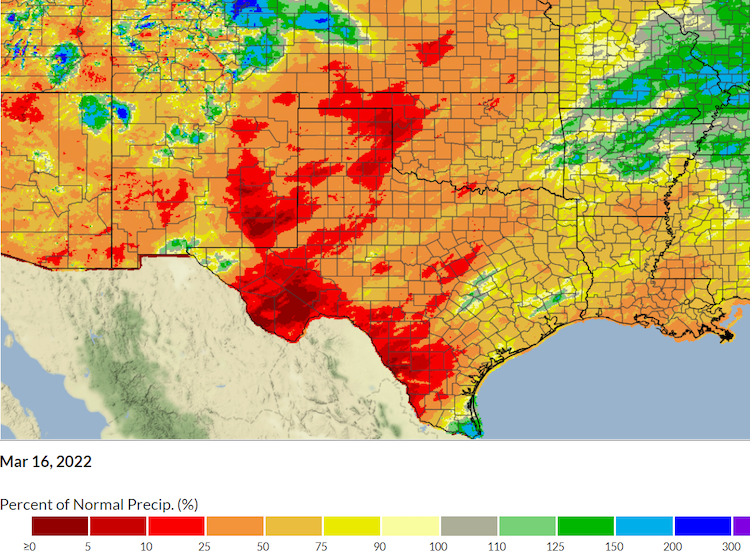
Drought Change Over the Past Month
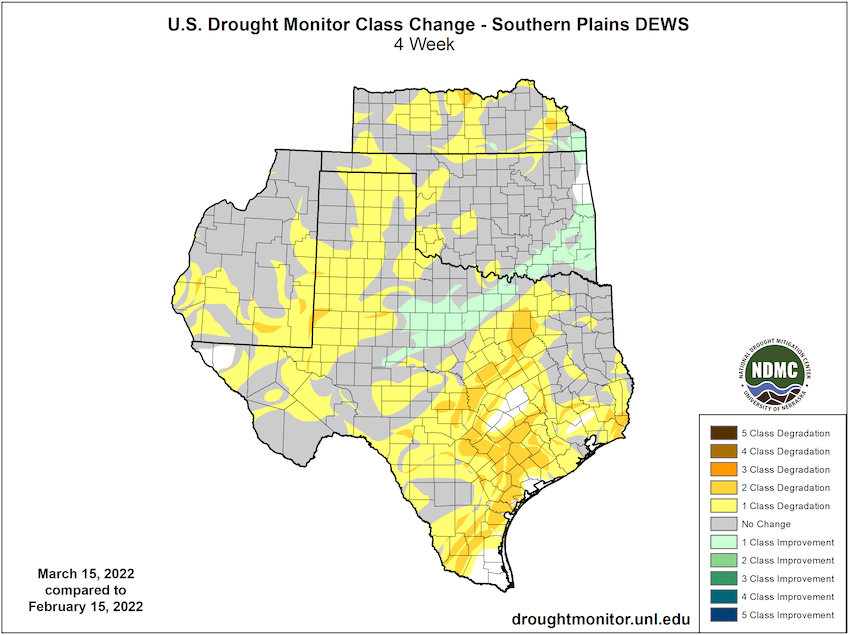
Recent and Forecast Precipitation
- Records of state-averaged precipitation for all states began in 1895 (127 years of record). In the 4 months since November 1, 2021, all Southern Plains states have seen precipitation totals ranking in the driest 10% on record. Precipitation values and percent of normal for each state for the period 11/1/21–2/28/22 are as follows:
- Kansas: 1.29 inches. 34% of normal. 4th driest such period on record.
- Oklahoma: 3.95 inches. 57% of normal. 13th driest such period on record.
- Texas: 3.46 inches. 52% of normal. 10th driest such period on record.
- New Mexico: 1.29 inches. 49% of normal. 12th driest such period on record.
- March usually provides about an inch of precipitation for western Kansas, Oklahoma, and Texas and a bit less than an inch for eastern New Mexico.
- So far, March 2022 has seen less than 0.1 inches for the drought-affected areas of these states.
- Forecast precipitation may bring March’s total to near average.
March Month to Date Precipitation
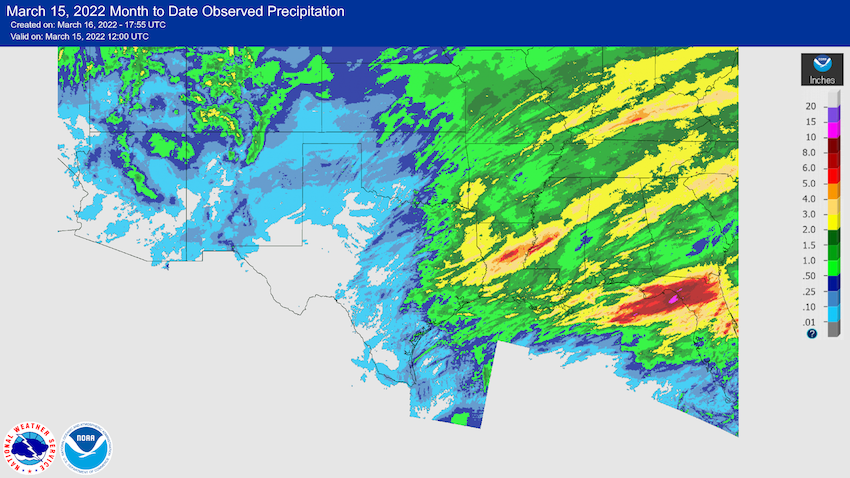
Quantitative Precipitation Forecast: March 17–24, 2022
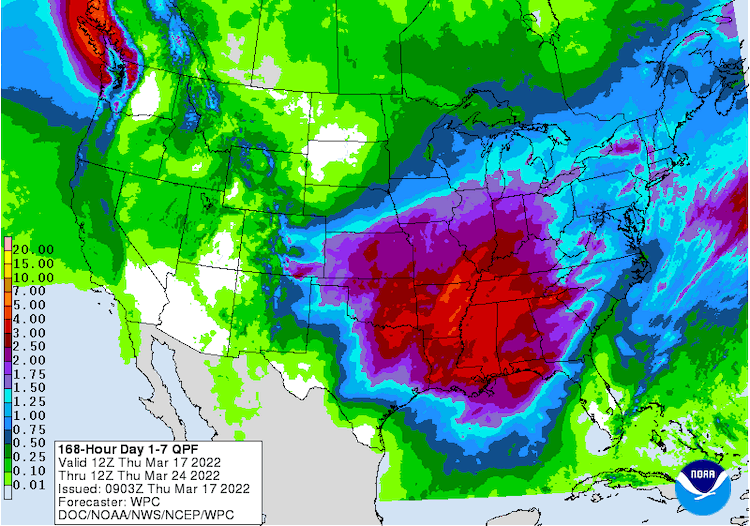
Soil moisture, as measured by the USDA Crop Condition and Soil Moisture Analytics (Crop-CASMA) Product, shows significant shortage of soil moisture across the region.
Soil Moisture Anomaly for Mid-March
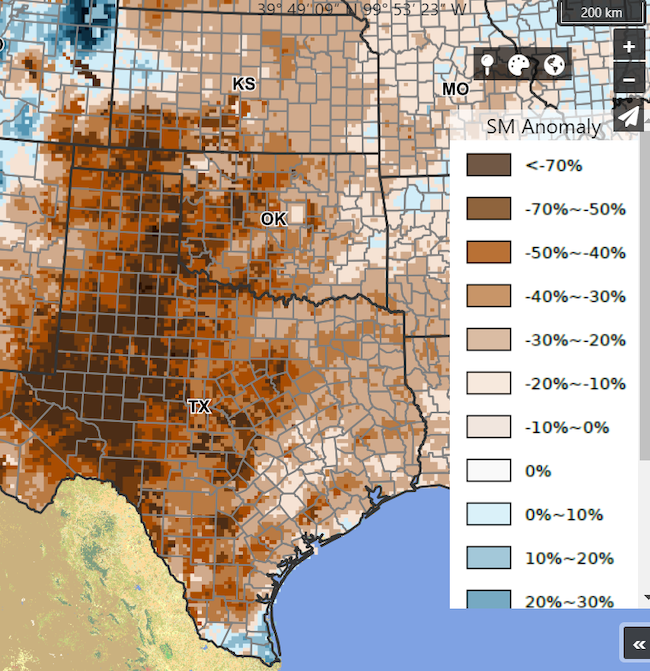
Forecasts and Seasonal Outlooks
April 2022
- Fire risk is elevated for drought-stricken areas of the Southern Plains
- Elevated fire risk is forecast to persist through spring.
- Much of west Texas and the Texas Panhandle have Energy Release Components that are near or at record high values for this time of year.
Significant Wildland Fire Potential Outlook: February 2022
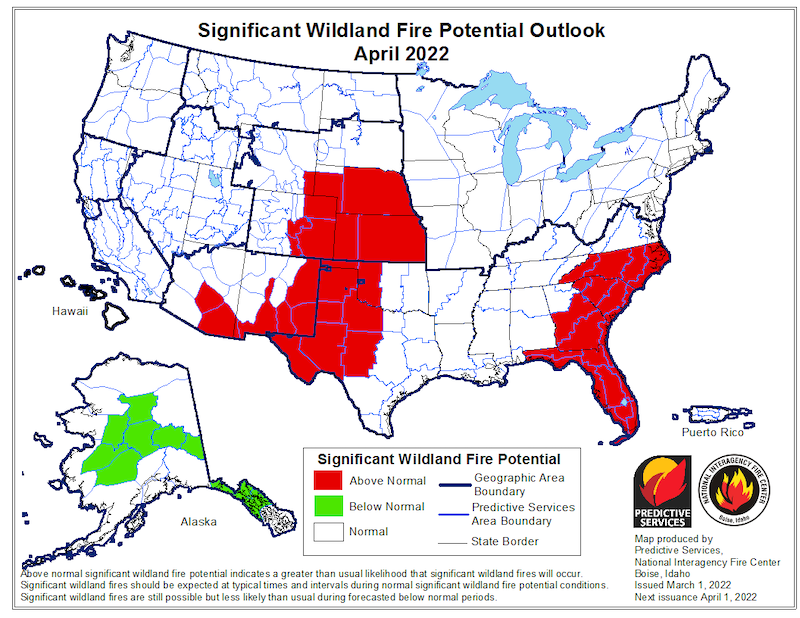
- The Climate Prediction Center's monthly outlook for April shows increased temperatures and decreased precipitation.
- The 4-week evaporative demand forecast shows increased Evaporative Demand Drought Index (EDDI) across west central Texas and southern Oklahoma.
April 2022 Temperature Outlook
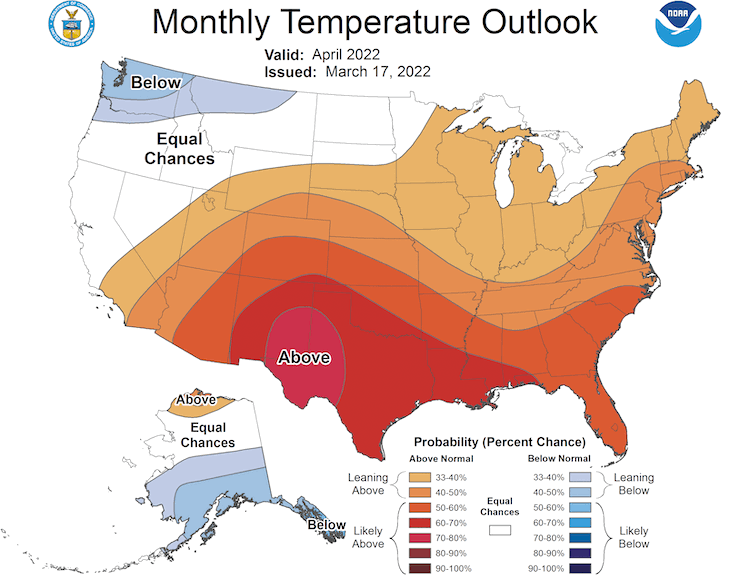
April 2022 Precipitation Outlook
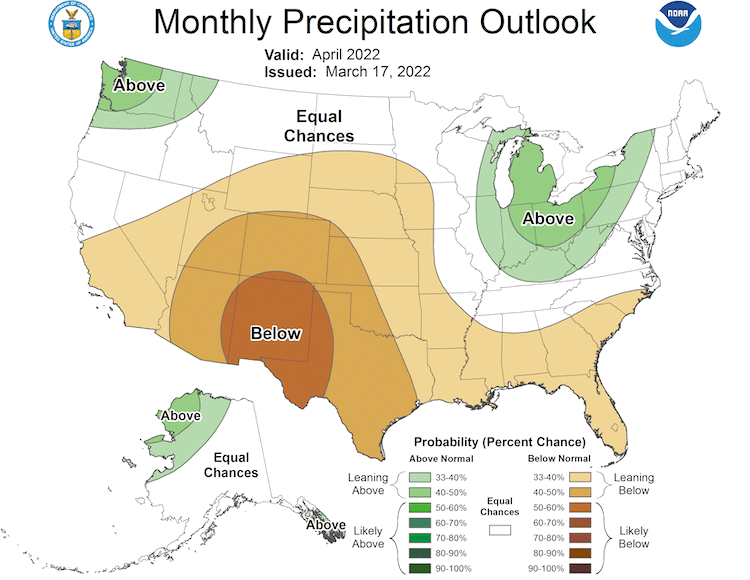
Evaporative Demand Drought Index (EDDI) 4-Week Forecast
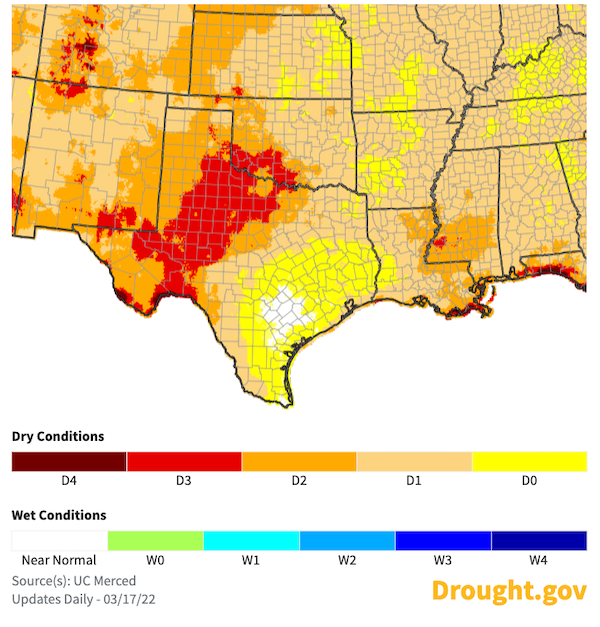
3-Month Outlook for April–June 2022
Seasonal forecasts show a hot and dry spring ahead for the Southern Plains:
- Spring is usually the wettest season for the Southern Plains, and spring rainfall is essential for agriculture in the region. Lower-than-normal precipitation is more likely than not for the entire region for the critical April through June time period.
- Odds strongly favor increased temperatures through spring 2022 for the Southern Plains states.
Three-Month Temperature Outlook: April–June 2022
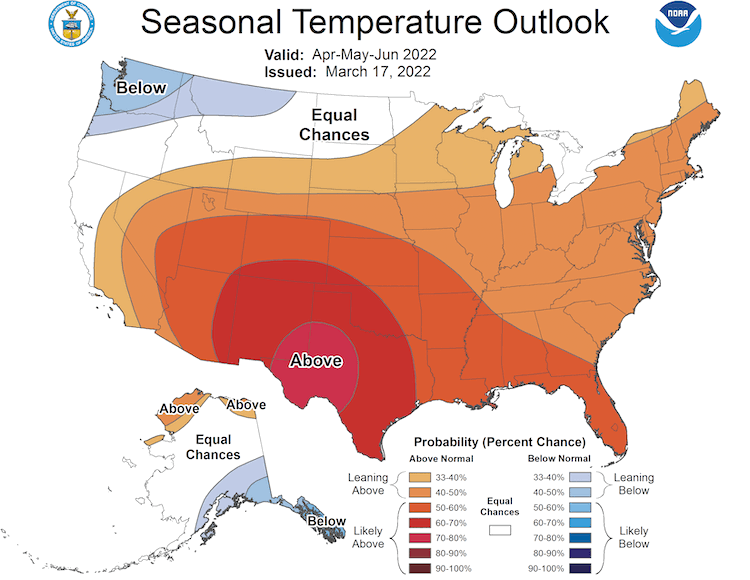
Three-Month Precipitation Outlook: April–June 2022
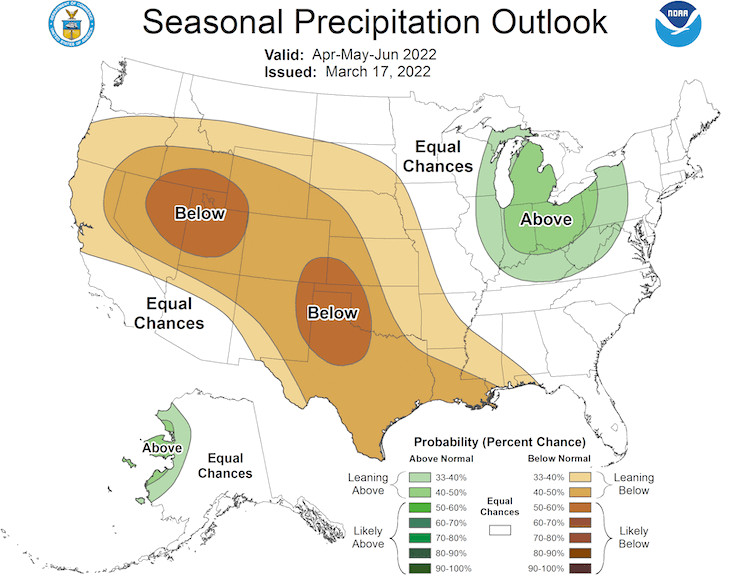
Seasonal Drought Outlook
- Drought is expected to continue for the Southern Plains through spring.
- The Climate Prediction Center's 3-month drought outlook shows drought remaining for all but northeastern Texas, much of Oklahoma, western Kansas, and northern Louisiana.
March 17–June 30, 2022 Drought Outlook
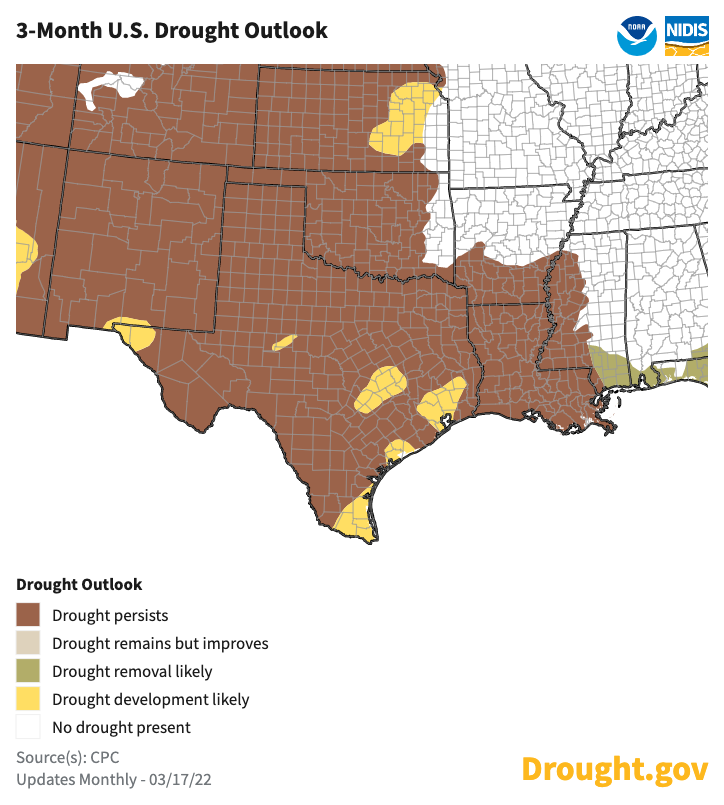
La Niña to Continue Through Spring and Possibly into Summer
- One of the primary drivers of drought across the Southwest (including Texas) this season was a La Niña pattern in the Pacific.
- February saw a small resurgence in cool sea surface temperatures in the central equatorial Pacific (the primary indication of a La Niña pattern). It is likely that La Niña conditions will persist into early summer.
- Spring precipitation is usually lower than normal in the Southwest, but the rest of the Southern Plains do not see a strong push toward wet or dry in a La Niña spring.
- For more information, please check out the NOAA El Niño–Southern Oscillation (ENSO) blog.
Sea Surface Temperature Anomalies (°C) for March 10–16, 2022
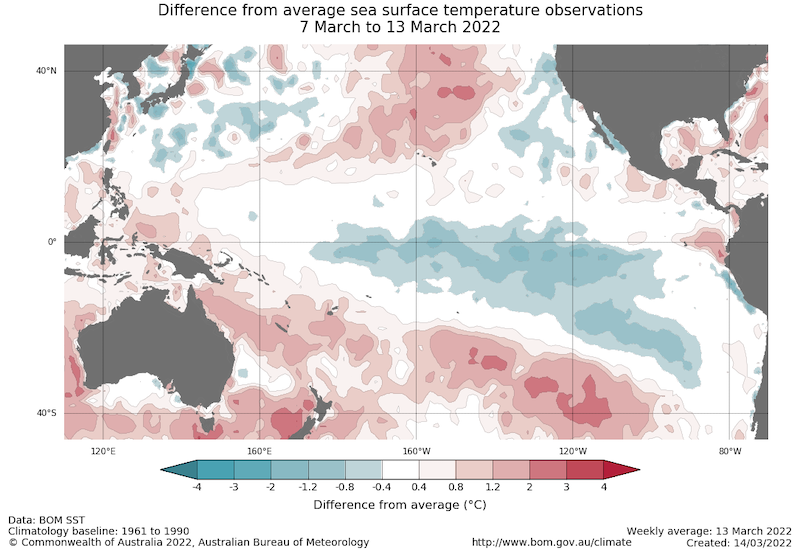
Risk of Wet/Dry Extremes in April–June During La Niña
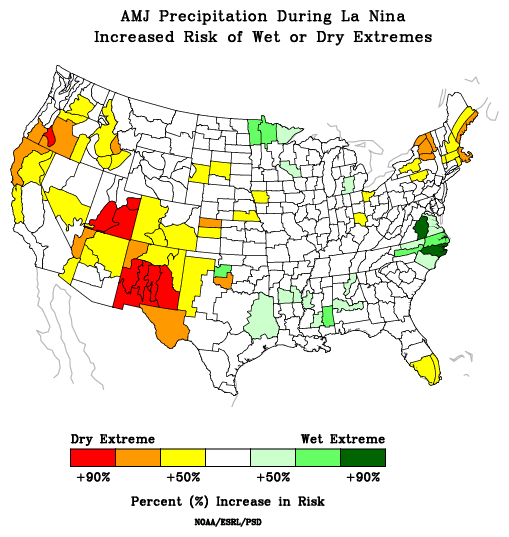
Probability of El Niño, La Niña, or Neutral Conditions
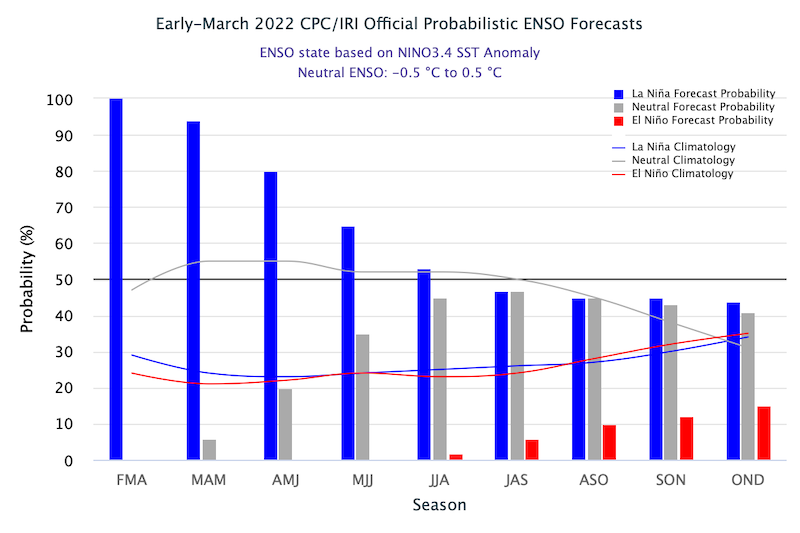
State-Based Conditions and Impacts
Kansas
- Significant wildfire near Hutchinson consumed over 130 structures and resulted in one fatality.
- Cover crop failures occurred in southeast Kansas due to poor growth before cold temperatures.
- Supplemental feed is necessary in southwest Kansas to sustain cattle herds due to poor foraging conditions.
County Precipitation Rankings: November–February
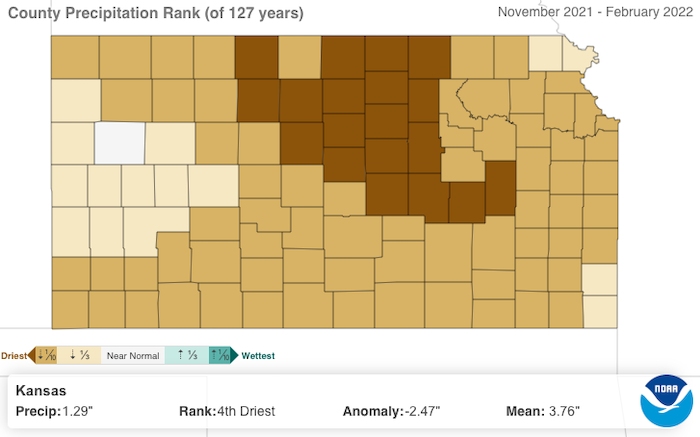
Oklahoma
- Nearly all counties in the western half of Oklahoma and the northern third of Oklahoma are experiencing top 10% dryness over the past 4 months.
- Long-term deficits have stressed Oklahoma’s winter wheat crop, with many areas seeing a profound lack of wheat pasture for grazing impacting Oklahoma’s livestock producers.
- Wildfires continue to be a concern, with 29 of Oklahoma’s 77 counties under a burn ban.
County Precipitation Rankings: November–February
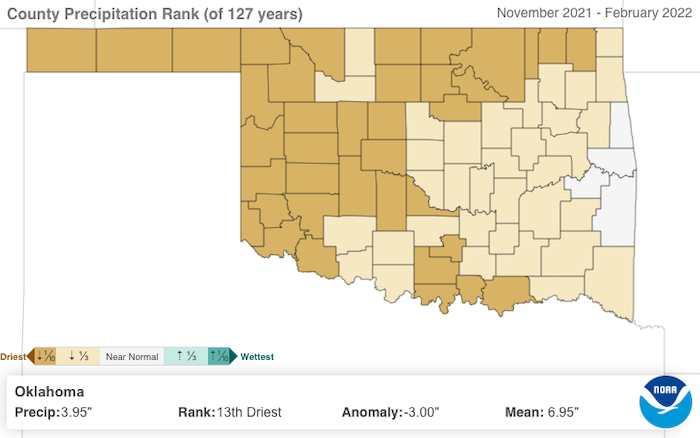
Texas
- The Texas Forest Service shows the Energy Release Component for fire development for much of western and central Texas above the 90th percentile for this time of year. The elevated threat of wildfires will likely last all spring.
- Over half of the winter wheat crop is presently rated as in very poor condition by the USDA. Ranchers in many areas are challenged by poor forage and low water supplies in stock tanks. Spring planting season is threatened by continued dry weather.
- Most counties experienced temperatures among the top 10% historically for the period August through February, exacerbating the dry conditions by accelerating evaporation.
- The dry conditions are contributing to the likelihood of above-normal temperatures in the seasonal outlook for Texas, reflecting a feedback cycle that worsens drought impacts.
County Precipitation Rankings: September–February
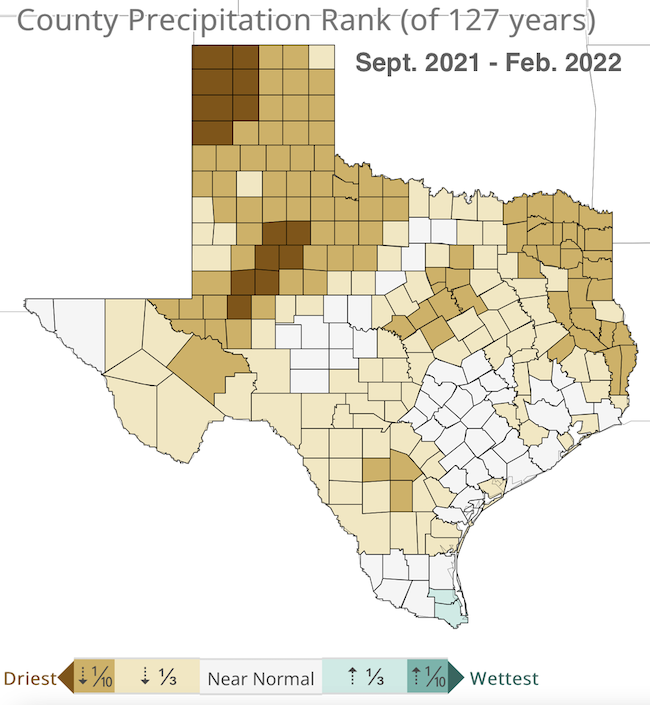
For More Information
NIDIS and its partners will issue future drought updates as conditions evolve.
More local information is available from the following resources:
Prepared By
Joel Lisonbee
NOAA/National Integrated Drought Information System (NIDIS), Southern Plains Drought Early Warning System and CIRES/CU Boulder
Gary McManus
Oklahoma State Climatologist, Oklahoma Mesonet, Oklahoma Climatological Survey
Chip Redmond
Kansas State University
John Nielsen-Gammon
Texas State Climatologist, Texas A&M University
Victor Murphy
National Weather Service
This drought early warning update is issued in partnership between the National Oceanic and Atmospheric Administration (NOAA) and the offices of the state climatologist for Texas, Oklahoma, New Mexico, and Kansas. The purpose of the update is to communicate a potential area of concern for drought expansion and/or development within the Southern Plains based on recent conditions and the upcoming forecast. NIDIS and its partners will issue future drought updates as conditions evolve.







